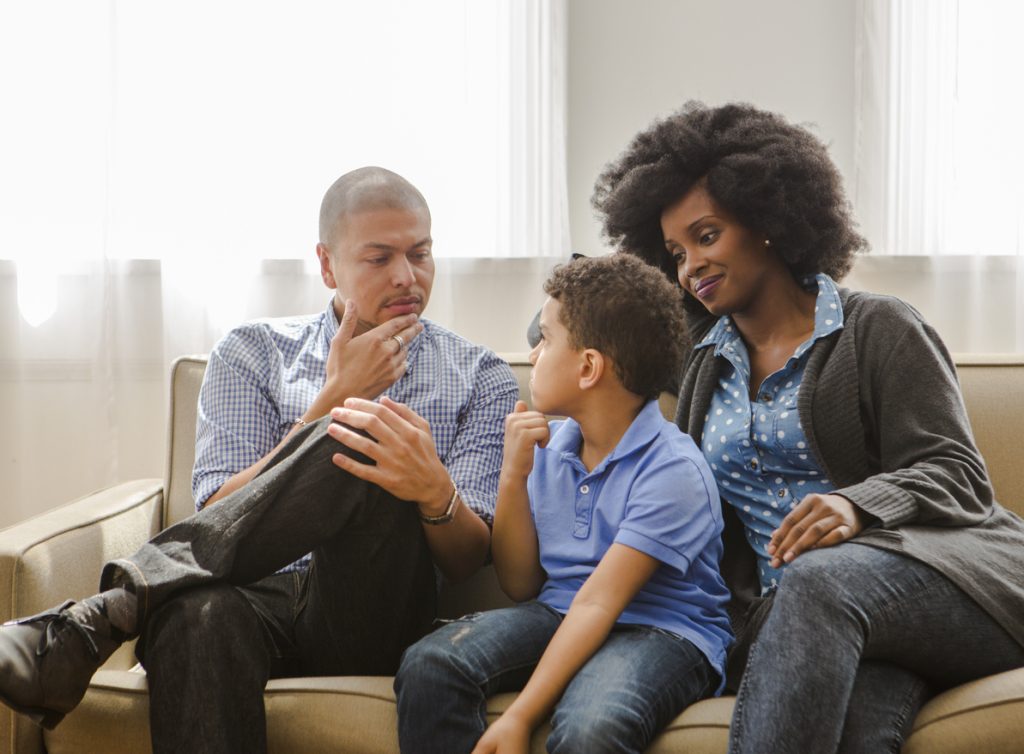Prep Yourself for the Birds and the Bees Conversation

Most of us would rather eat nails than talk to our kids about sex, but this aversion to ‘the birds and the bees” is jeopardizing important information our children need to learn.
The sex talk for today’s generation is definitely not the sex talk of the past. Gone is the hush-hush embarrassed discussion of mechanics passed on from mother to daughter and father to son.
Today the talk should be a conversation, with diverse talking points along the way. The lofty goal of any sex-positive parent is to take the conversation beyond the physical side of sexual intercourse and empower their kids to make good decisions about their bodies beyond the birds and the bees. This means teaching them to find pleasure in their sexuality, understand the importance of consent, and navigate the modern sexual landscape.
But what should your kid know and when? We asked Cory Silverberg, a noted sex educator and author of What Makes a Baby, and Marnie Goldenberg, a ‘sexplainer‘ on a crusade to raise sexually intelligent kids, if there is a timeline parents should follow to teach their kids about sex.
They both agreed it is important to have an open environment where kids feel safe to ask questions. It may be hard, but parents should answer questions without embarrassment and should never make kids—of any age—feel that their bodies are dirty or shameful. Goldenberg says parents should want to be the people who their kids come to with their questions, because that will give them a chance to impart their values about sex and relationships.
The Birds and the Bees: Start Early, Talk Often
Here’s what you should be letting your kids know and when. We started at the very beginning, because the odds are, like most parents in Canada, you’ve skipped a few steps along the way.
Two-Year-Olds
Their bodies: Two-year-olds should know the names of all body parts, including penis, vagina, and vulva. Why vulva? Goldenberg says that the vulva is what children see when they look at their own body. Parents can explain that the vagina is the internal part where babies come out.
Bath time is the perfect time to go over these things, says Silverberg. When singing ‘Head, Shoulders, Knees and Toes,’ add in everything. Try singing: ‘head, shoulders, knees and penis/vulva.’
Studies have shown that children who use the proper names for their body parts are less likely to be sexually exploited, says Goldenberg.
Three- to Five-Year-Olds
Making babies: This is the time when kids may start to notice pregnancies around them. Answer their questions directly and follow their lead. Tell them that, to make a baby, you need an egg and a sperm. The sperm and egg mix together and result in a baby. You can even add that daddy has the sperm and mommy has the egg, and they danced together and made you. They don’t need to know about the explicit act of intercourse at this age, but don’t be afraid to tell them, Goldenberg says. And you can share that the baby comes out of a woman’s body through the vagina or through a small incision. The doctor or midwife helps the baby come out.
Their bodies: The way parents act as role models is very important to young kids. How we talk and treat our own bodies teaches our kids how to feel about themselves. They should know body parts and their functions.
‘Kids are curious,’ Silverberg says. ‘Explain that the pee comes out of the urethra and the baby comes out of the vagina.’ This is important in case they ever need to explain to a doctor what hurts, he says.
Six- to Eight-Year-Olds
Making babies: Six- to eight-year-olds might be curious about the mechanics of sexual intercourse. Sometimes parents fear that telling them will ruin sex (make it something to be afraid of) or take away their innocence, says Silverberg. But this is not true, especially if parents examine their own fears and approach the conversations in a matter-of-fact way.
If your kids aren’t curious or haven’t asked you any questions about sex, you don’t get a pass to ignore the topic altogether, Goldenberg says. Children this age talk in the schoolyard, and your kids may be getting the facts wrong from their friends. This is your chance to give the correct information in the context that you find appropriate and with the values you find important.
Their bodies: This age group should know their bodies are theirs alone, and that they can feel good. Ask your child, ‘What makes your body feel good? Does running, stretching or eating something delicious make your body feel good?’ Reinforce that their body is theirs, and other people can’t touch them or give them hugs without consent.
Kids this age are exposed to a variety of media messages. Take advantage of sexual topics in commercials and movies by making them into teaching moments. Encourage kids to ask you questions about what they saw, whether it is a tampon commercial or a kissing scene.
Eight- to Ten-Year-Olds
Making babies: They may have more technical questions about pregnancy and birth at this age, as well as questions about sexual relationships. Answer those questions openly and without judgement, because you are setting the stage for puberty, a time when they will become even more aware of sex. If you don’t know how to answer something, be honest and return with an answer at a later date.
Their bodies: This is the pre-eye-roll stage, says Goldenberg, so it’s the time to start talking about puberty—before it happens. Girls and boys should learn about menstruation.
Goldenberg explains it this way: ‘A period is something I get—most women do—when my body is not making a baby. It tells me that my body is working. It is water mixed with a little blood that my body doesn’t need anymore. The blood and water builds up in my uterus over a month as a little waterbed for a baby in case I get pregnant. It would be a cozy place for a baby to grow. But when it isn’t used, it comes out of my vagina. It doesn’t hurt and, though it looks bloody, I am not cut inside.’
Tweens and Beyond
Making babies: Now is the time to make sure your kids know about pregnancy prevention and how to stop sexually transmitted infections. The birds and the bees have flown the nest.
Their bodies: Conversations with your teen should empower them to be able to speak openly with their partners.
Kids should understand says Goldenberg. Ask them what they think consent means or what they think it should look like, says Goldenberg. Boys and girls should be thinking about what a ‘yes’ looks like—not just what a ‘no’ is like.















